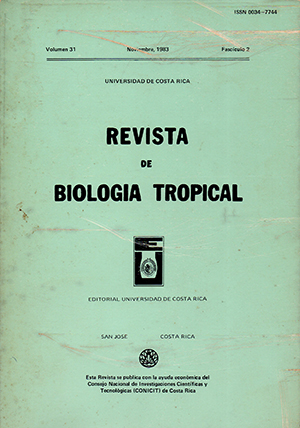Resumen
La historia natural del abejón picudo barbado Rhinostomus barbirostris fue observado en el occidente de Colombia donde las larvas minan troncos caídos de palmas, y concuerda con las descripciones previas de regiones en donde esta especie es una plaga del coco. Se determinó que algunas de las características secundarias sexuales de los machos adultos (pico más largo, patas primeras más largas, y mayor actividad y agresividad) sirven en las peleas que se desencadenan entre machos alrededor de hembras que están perforando al tronco para ovipositar. Otra característica (la densa pilosidad sobre el pico y en la superficie ventro-anterior del torax del macho) puede servir como parte del cortejo del macho, pero esta explicación no es completamente convincente.
Existe una gran variedad de tamaños entre los adultos, aparentemente por diferencias en el sustrato donde minan las larvas. Los machos grandes casi siempre ganan a los más pequeños en peleas abiertas. Estos últimos emplean dos tipos de comportamiento especial que parece ser diseñado para compensar en algo esta inferioridad como peleadores. Así es posible que los machos sean polimórficos en cuanto a su comportamiento agresivo, pero no hubo señal de un polimorfismo en cuanto a las armas morfológicas, ya que la relación largo del pico-tamaño del cuerpo fue estrictamente lineal. El comportamiento de los machos sugiere que en esta especie la hembra tiende a utilizar los espermatozoides del último macho con el cual haya copulado para fecundar cada huevo que pone.
Citas
Arrow, G. 1951. Horned Beetles: a study of the fantastic in nature. Dr. W. Junk, The Hague.
Bartlett, A.C., E. B. Mattix, & N. M. Wilson. 1968. Multiple matings and use of sperm in the boll weevil, Anthonomus grandis. Ann. ent. Soc. Am. 61: 1148-1155.
Bondar, G. 1940. Insetos nocivos e molestias do coqueiro (Cocos nucifera) no Brasil. Tipografía Naval, Bahia.
Eberhard, W. G. 1977. Fighting behavior of male Colofa porteri beetles (Scarabeidae: Dynastinae). Psyche 83: 299-298.
Eberhard, W.G. 1979. The function of horns in Podischmus agenor (Dynastinae) and other beetles, p. 23 1-258. In M. Blum and N. Blum (eds). Sexual selection and reproductive competition in insects. Academic Press, N. Y.
Eberhard, W. G. 1980. Horned beetles. Sci. Amer., 242: 166-182.
Eberhard, W. G. 1982. Beetle horn dimorphism: making the best of a bad lot. Amer. Nat., 119: 420-426.
Espinal, L. S. & E. Montenegro. 1963. Formaciones vegetales de Colombia. Inst. Geográfico "Agustín Codazzi". Bogotá.
Khan, N. R. & A. J. Musgrave. 1969. Observations on the functional anatomy of the reproductive organs of Sitophilus (Coleoptera: Curculionidae). Can. J. Zool., 47: 386-392.
Kuyten, A. 1964. Allometrie und Variabilitat bei Lucanus mearesi Hope (Coleoptera, Lamellicornia). Z. Morph. Okol. Tiere, 54: 141-201.
Pace, A. 1967. Life history and behavior of a fungus beetle. Bolitotherus cornutus (Tenebrionidae). Occ. Pap. Mus. Zool. Univ. Mich., 653: 1-15.
Palmer, T. J. 1978. A horned beetle which fights. Nature, 274: 583-584.
Vaurie, P. 1970. Weevils of the tribe Sipalini (Coleoptera, Rhynchophorinae) Part 1. The genera Rhimostomus and Yuccaburus. Amer. Mus. Novit., 2419: 1-57.
Villavaso, E. J. 1975. Functions of the spermathecal muscle of the boll weevil, Anthonomus grandis. J. ins. Physiol. 21: 1275-1278.
Walker, W. 1980. Sperm utilization strategies in nonsocial insects. Am. Nat. 115(6): 780-799.
Wojcik, D.P. 1969. Mating behavior of 8 storedproduct beetles (Coleoptera: Dermestidae, Tenebrionidae, Cucujidae, and Curculionidae). Fla. Ent. 52(3): 171-197.
Wolcott, G. N. 1933. An economic entomology of the West Indies. Ent. Soc. Puerto Rico, San Juan, Puerto Rico.
##plugins.facebook.comentarios##

Esta obra está bajo una licencia internacional Creative Commons Atribución 4.0.
Derechos de autor 1983 Revista de Biología Tropical






